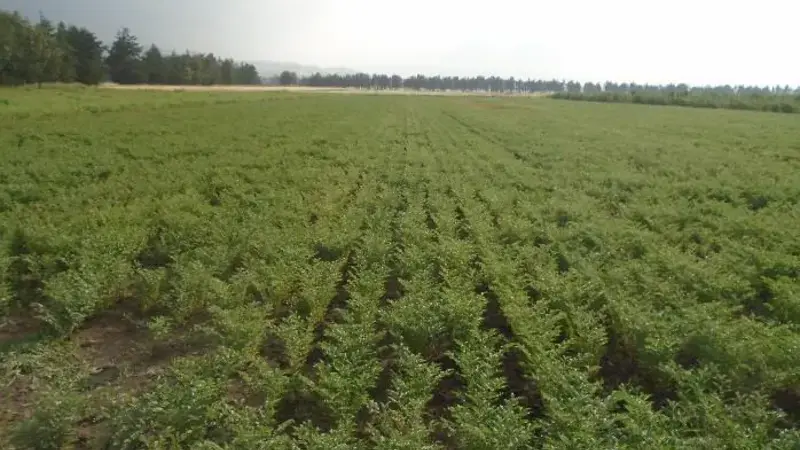A chickpea revolution in Ethiopia

An initiative in the Ethiopian highlands is pioneering mechanized chickpea production. Previously neglected because of the crop’s dependence on traditional farming practices and high labor costs, new higher-yielding, and machine-harvestable varieties are gaining popularity and laying the foundations of a lucrative export-oriented farming system.
Chickpea is a versatile crop with multiple benefits for integrated crop-livestock smallholder farming systems. It is an important source of protein and micro-nutrients; improves soil fertility and health through nitrogen fixation; has a low carbon footprint and aids climate change mitigation; and is easily incorporated into crop rotations – often with wheat and teff - to ensure the sustainability of farming systems. It can also be a significant contributor to household incomes, and in international markets can secure reserves of foreign currency.
In Ethiopia, in response to the introduction of improved varieties and crop management practices, chickpea has become increasingly popular. Large-seeded Kabuli varieties and those resistant to Ascochyta Blight - a severe disease that affects most chickpea-growing regions of the world - have increased domestic production and fueled international exports. The crop is now cultivated by almost 0.7 million households on an estimated 242,703 hectares (ha) of land, and in 2018 total production reached 499,426 tons, with average productivity of 2.058 tons per ha-1. Chickpea has emerged as the country’s third most important export crop among legumes, generating US$61 million annually.
Despite this progress, however, productivity and land area continue to fall short of the crop’s potential. Estimates suggest chickpea could be grown on an estimated two million ha of highly suitable land and could generate up to five tons per ha-1. One area that could benefit is the Bale Highlands, a region located in the southeast of Ethiopia. Largely dependent on the mono-cropping of wheat, farmers here are accustomed to mechanized production and tend to neglect chickpea because it requires manual planting and harvesting, and therefore incurs high labor costs.
Promoting mechanized chickpea production
In order to reverse this situation, ICARDA and the Debre Zeit Agricultural Research Center (DZARC), with support from USAID, initiated efforts to mechanize chickpea production and develop and disseminate machine-harvestable chickpea varieties. Initially, researchers piloted machine planting and harvesting at two locations in the Oromia region: Gonde Basic Seed Farm, owned by the Ethiopian Seed Enterprise, and Kulumsa Agricultural Research Center. They introduced two chickpea varieties: ‘Dhera,’ a high-yielding and erect variety of Kabuli chickpea, and ‘Naatoli,’ a high-yielding and early-maturing Desi chickpea. Performance overall was positive (see Image 1); although the results also suggested that planting dates should be adjusted from late July to early August to avoid soil crusting due to high levels of soil moisture.
Accelerated scaling efforts
Encouraged by the demonstration trials, the initiative subsequently demonstrated the viability of large-scale chickpea production systems, partnering with Bale Green, a private enterprise estate farm, in two districts, Ginir and Goro. Some 269 farmers, including 30 female farmers, were given 22.5 tonnes of source seed – of the chickpea varieties ‘Areti’ and ‘Habru’ – and planted the seed on a 172 ha area of land.
Bale Green provided agricultural farm services - planting, spraying, and harvesting – and another business, Dejen Gebremeskel Import and Export Company, provided inputs such as biofertilizers and agrochemicals, and sponsored field days to promote the varieties. External support was also provided: Fintrac provided training for farmers under the USAID ‘Feed the Future-Ethiopia Value Chain’ initiative. The Bale Zonal Bureau of Agriculture provided overall coordination.
Some 602 tons of chickpea were harvested in February 2019, yielding an average 3.5 tons per ha-1. The harvested crop was delivered to exporters at a negotiated price, providing an assured market for farmers. “Linking farmers with markets is what matters most,” explained Dr. Zewdie Bishaw, Principal Investigator of the initiative. “Markets are drivers of adoption and therefore increased production.”
Approximately 22.5 tons of the total production is expected to be set aside as part of a revolving seed scheme, increasing seed production for next year’s cycle, facilitating dissemination, and expanding the cultivated area.
Mr. Nigusie Girma, a breeder and national coordinator of the Chickpea and Lentil Program at the Ethiopian Institute of Agricultural Research, commenting on the initiative’s progress, said: “The success of this initiative has demonstrated that large-scale chickpea mechanized production systems can flourish in regions that have previously neglected the production of this crop. By building on this model, we can extend the benefits of chickpea to farmers throughout Ethiopia, thereby strengthening food and nutritional security, enhancing soil fertility, and generating additional income.”
Mr. Million Bogale, General Manager of Bale Green stressed that “the demand for improved chickpea is exponential,” referred to the initiative as a “rewarding and overwhelming experience,” and claimed that thousands of farmers were already requesting access to the new varieties.
These sentiments were shared by Mr. Nigusie Tola, a member of the Chefe Mana Keble Farmers Association, an organization from Goro district that also participated in the initiative: “All farmers are happy with the introduction of the chickpea varieties into their farming systems.” He continued: “Apart from its multiple benefits, chickpea productivity could equal, or even surpass wheat, in terms of economic returns. We believe that farmers will want to continue and expand chickpea production in the future”.
Efforts to mechanize chickpea production in Ethiopia were part of a wider USAID-supported initiative entitled ‘Better livelihoods for small holder farmers through knowledge-based technology interventions in the highlands of Ethiopia: Increasing the productivity of chickpea in wheat-based cropping system.’ This multifaceted project was implemented by ICARDA (2015-2018) in collaboration with partners and development practitioners at the federal and regional levels, including NARS, seed suppliers, extension services, and the private sector.
